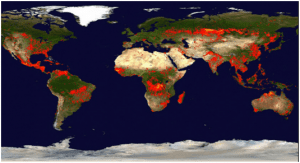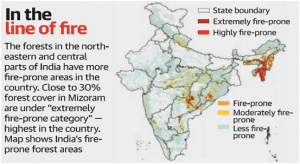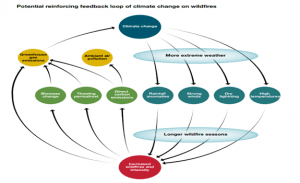THE CONTEXT: Throughout the globe, wildfires are growing in intensity and spreading in range. From Australia to Canada, the United States to China, across Europe, the Amazon and pockets of India, wildfires are wreaking havoc on the environment, wildlife, human health, and infrastructure. Climate Change is to blame for most of the forest fires occu rring across the world.
Globally, only around 4% of all forest fires have natural causes such as lightning. In all other cases, the anthropogenic origin of the fires is common.
THE RECENT FOREST FIRES (2022-2023)
- Wildfires in Hawaii (Lahaina)
- USA: Northern California
- Canada: British Columbia and Alberta province
- Russia: Black Sea town of Gelendzhik
- Zombie fires in Canada and Siberia (Russia)
- Spain: Tenerife, Canary Islands and La Palma
- Greece: Plataniostos in Evia Island; city of Alexandroupolis, Evros region
- Fires in Italy
- India: Fires in Simlipal National Park (Odisha), Goa
- Australian bushfires
- South Central Chile: Ñuble, Maule, Biobío and Auracanía.

DELVING DEEPER INTO REASONS BEHIND RAVAGING FOREST FIRES THIS YEAR IN EUROPE AND OTHER PARTS OF THE WORLD
As concluded by the IPCC Synthesis Report 6, the global mean temperatures have already risen by more than 1°C. And there has been unprecedented rise in extreme weather events including heatwaves, droughts and Arctic Amplification, all of which are known to influence the global climate and elevate dryness in atmosphere, sucking up all moisture and thus, triggering forest fires.
HAWAIIAN WILDFIRES(MUII)
Wildfires were once uncommon in Hawaii, ignited largely through volcanic eruptions or lightning strikes. But in recent decades, human activity has made them more common and extreme.
A combination of factors played a role in fuelling forest fires in the Hawaiian island recently:
- Dry weather: Drought has gripped about 80% of Hawaii. 90% of Hawaii is getting less rainfall than it did a century ago, particularly since 2008, thanks to the Climate Change.
- Hurricane winds: Strong winds from Hurricane Dora fuelled the fires.
- The last major fire in Hawaii occurred in 2018, when winds from Hurricane Lane whipped up the flames around Lahaina.
WILDFIRES IN EUROPE
- POLAR AMPLIFICATION: The rise in global temperature in the past few years have caused deviations above the normal by as much as 15 degrees in Antarctica, and by more than 3 degrees in the north pole.
- These unusually higher temperatures in polar regions have also induced changes in old wind patterns.
- These changes turned western Europe into what has been described as a “heat dome” — a low pressure area that began to attract hot air from northern Africa.
- Extreme temperatures and a lack of rainfall are serious issues in southern Italy and are linked to climate change.
FOREST FIRES IN THE USA (2022-2023)
- CHANGES IN JET STREAMS: In the case of the U.S., the record temperatures are being linked to changes in the jet stream — a narrow band of westerly air currents that circulate several kilometres above the earth’s surface.
- While a conventionally strong jet stream would bring cooler air from the northern Atlantic, in recent years the jet stream has weakened and split into two, leading to intense and more frequent heat waves over parts of the American continent.
FOREST FIRES IN CHILE
- Reeling under conditions of mega-drought and water crisis due to extreme heatwaves, the Southern-Central Chile experienced serious forest fires in the month of February, 2023.
VULNERABILITY OF INDIA TO FOREST FIRES
According to the State of Forest Report 2021 brought out by the Forest Survey of India (FSI), approximately 22 per cent area of forest cover in India falls under the highly and extremely fire-prone category.

According to a CEEW (Council on Energy, Environment and Water) study, more than 75% of Indian districts are extreme forest fire hotspots. Over 1000 forest fires throughout India have been recorded in a single week of February this year (2023) which is worrisome!
Numerous incidences of forest fires have been recorded in India since 2022; for instance: Rajasthan’s Sariska Tiger Reserve, Odisha’s Similipal Wildlife Sanctuary, Madhya Pradesh’s Ladkui jungles in Sehore district, near the Kodaikanal hills of Tamil Nadu’s Dindigul district among other areas.
WHAT ARE THE CAUSES OF FOREST FIRES? LET’S FIND OUT!!!
NATURAL CAUSES
- Lightning: Lightning is much likely to trigger wildfires that are considered dangerous as they spread quickly. E.g; Forest fires in Canada’s British Columbia and Alberta provinces (2023)
- 90% of forest fires in the boreal forests of northern Canada and Alaska are triggered by lightning.
- Dry climate: Lack of adequate moisture and soaring temperatures are naturally bound to induce wildfires.
- According to a study, increased temperatures and resultant aridity have increased the number and spread of forest fires in USA in last 30 years.
- Volcanism: The spreading of hot lava to surrounding lands causes wildfires when the dry vegetation gets ignited.
- Rubbing of stones: Forest fires are also triggered by rubbing of dry sticks and rolling of stones.
- Nature of vegetation: Pine needles are highly fire-prone and so pine forests in the Himalayan states of India are very prone to fires.
ANTHROPOGENIC CAUSES
- Climate Change: The increasing temperatures and dryness, rising frequency of extreme weather events like heatwaves and droughts have aggravated the situation and resulted in remarkable uptick in the incidences of forest fires throughout the world.
- The zombie fires in Canada and Siberia have risen with growing dryness in Arctic soils on the account of changing climatic conditions. The Arctic Amplification is responsible for such wildfires.
- Poaching: The forest fires in Odisha, India are attributed to poaching. The poachers in order to hunt wild animals start wildfires.
- Shifting cultivation: The faulty agronomic practices like jhumming ignite fires in the adjoining forests is the case with North-East India and Amazon forests in Brazil.
- Accidental fires: Accidental fires break out due to camp-fires, sparks from vehicular exhaust and cigarettes.
- Collection of non-timber forest products (NTFPs): According to a World Bank report, people in Central India burn to aid in the collection of flowers from the mahua plant (Fires in Simplipal National Park), during collection of tendua leaves for bidi making etc.
HOW DO FOREST FIRES IMPACT THE ENVIRONMENT, SOCIETY AND ECONOMY? STUDYING IMPLICATIONS THROUGH BROAD SPECTRUM!!!
- Loss of vegetation cover: The degradation of forests on the account of wildfires changes the landscape and nature of forests inhabiting the region. The open forests and grasslands have increased at the expense of dense forests like Amazon and Congo rainforests.

- Loss of biodiversity: The hotspots of biodiversity are heavily affected due to forest fires. The loss of precious umbrella species, specialist species and keystone species lead to ecological imbalance, further increasing the risks to survival of species with the tendency for increased inbreeding due to habitat loss and fragmentation.
- Global Carbon emissions: Wildfires around the world emitted 1.76 billion tonnes of carbon in 2021 according to the European Union’s Copernicus satellite data. This is the equivalent of 6.45 billion tonnes of carbon dioxide and was 148 per cent more than the total fossil fuel emissions of the European Union.

- Effect on polar areas: The particulate matter released from forest fires has been found in the snow of polar areas, which has the potential to adversely affect the albedo and consequently, cause further warming of the Arctic.
- Reduction in carbon sinks: The zombie fires in the regions of permafrost further raise apprehensions due to reduction in carbon sinks(peatlands) and release of methane, a greenhouse gas having global warming potential higher than CO2. Peatlands are being destroyed by wildfires which induces positive carbon feedback cycle.
- Economic losses: When the flames reach areas inhabited by people, they can claim many lives and engulf swathes of productive agricultural lands. The tribal communities dependent on forest produce for livelihood suffer with the loss of timber and non-timber forest produce due to wildfires.
- Air Pollution and health impacts: The release of toxic gases, particulate matter and creation of haze and smog as result of wildfires poses health challenges due to contaminated air. E.g., Smoke from the Siberian wildfires choked the nearby cities for months and spread across the Pacific Ocean to reach Alaska.
- PM2.5 can penetrate the lung membranes when breathed in, damaging the respiratory system and passing into the blood stream.
- Respiratory and cardiac diseases due to air pollution are much prevalent effects.
- Degradation of Catchment Areas: Following an incidence of wildfire, increased erosion rates and changes in runoff generation and pollutant sources may dramatically increase the influx of sediments, nutrients and pollutants, potentially contaminating water supplies and leading to environmental concerns like eutrophication and dead zones.
ARE THERE ANY BENEFITS FROM FOREST FIRES? THE ANSWER IS YES!!!
- In natural forest systems, fire plays a very important role.
- It is one of the methods for the natural recycling of nutrients often helping the tree species to regenerate.
- The fire ecology often removes invasive weeds and helps in maintaining habitat for wildlife.
THE EXISTING MEASURES IN INDIA TO ADDRESS THE INCREASING FOREST FIRES
- Early Warning: The Forest Survey of India developed in 2016, an indigenous “Early Warning Alert System for Forest Fire”. The alerts to State Forest departments are based on parameters like Forest Cover, Forest Type, and Climatic Variables (Temperature and Rainfall).
- Legislative framework: As per, sections 26 and 33 of the Indian Forest Act of 1927, it is a criminal offense to burn or to allow a fire to remain burning in reserved and protected forests. Section 30 of the Wild Life (Protection) Act of 1972 further prohibits setting fire in wildlife sanctuaries.
- National Action Plan on Forest Fires (NAPFF): It has been formulated to minimize forest fires by informing, enabling, and empowering forest fringe communities and incentivizing them to work in tandem with the forest departments.
- Forest Fire Prevention and Management Scheme: In 2017, Intensification of Forest Management Scheme was revised and replaced with Forest Fire Prevention & Management Scheme. It aims at minimising forest fire incidences through partnership with forest fringe communities. It also emphasises on the preparation of a fire danger rating
- State-level interventions: Over the past 10-15 years, remote sensing has been used extensively for forest fire detection in India. State-level detection and alert systems have also been developed in states of Madhya Pradesh, Andhra Pradesh, Chhattisgarh, Telangana, and Uttarakhand. Telangana is the only state to have digitized locations of fire lines.
- Draft National Forest Policy, 2018: To protect the interest of tribals, the Draft Policy of 2018 proposes to launch Community Forest Management Mission for management of community forest resources though a participatory forest management
NDMA GUIDELINES TO MANAGE FOREST FIRES
Major recommendations include:
- Incorporate Forest Fire Prevention and Management (FFPM) in existing policy and planning documents
- Establish National Forest fire Knowledge Network
- Capacity building of forest officials for better use of early warning systems
- Assess risk and prepare vulnerability and risk maps
- Document national and international good practices and utilise them for making forest fire management more effective and practical
- Increase community awareness
HOW CAN THE FOREST FIRES BE MITIGATED? STUDYING THE WAY FORWARD!!!
UNEP has projected in its report “FRONTIES REPORT 2022” that the number of wildfires is likely to increase by up to 14% by 2030. The report has made following recommendations:
- Hazard mapping- Based upon the past experiences and recent occurrences, the regional and national authorities must maintain updated database of forest fires for holistic understanding of trends by the policy makers. National Forest fire Knowledge Network driven by this data should be created.
GLOBAL BEST PRACTICES BASED ON CUMMUNITY PARTICIPATION:
In 2003, Indonesia launched the Fire Care Community programme which established a regional fire alert system that engaged companies and civil society organisations in training forest communities and equipping them to monitor and mitigate fires.
Learning from Canadian best practice (2023): The fire prevention zone — an area carefully cleared to remove fuel and minimise the spread of flames — was created by a logging company owned by a local Indigenous community. A well-placed and well-constructed fire prevention zone can, under the right conditions, save homes and lives.
- Participatory approach- Appreciating and adopting indigenous fire management techniques can prove much useful since the forest communities are the first to detect wildfires and are the first line of defence.
- Long-range weather forecasting- The rising frequency of El Nino and marine heatwaves have compounded the risks to forests of the world. It becomes imperative to upgrade the existing weather modelling and forecasting systems through expansion of the global network of sensors and satellites complemented with satellite monitoring.
- Technological interventions- Focus on remote-sensing capabilities like satellites, ground-based radars lightning detection as well as data handling.
- Insurance as mitigation tool- Insurers rely on catastrophe modelling (CAT models), which combine hazard models with existing asset vulnerabilities to predict losses. Better collaboration between wildfire scientists and actuaries could enhance CAT modelling and mitigation efforts.
- Awareness and Capacity building- Community awareness about forest fires due to callousness, illegal activities and Climate Change must be spread. Adequate emphasis must be given to capacity-building of forest officials for better use of early warning systems.
- Landscape fuel management- Strategies to address the fire behaviour include landscape fuel management to reduce the amount of vegetation and vegetative debris available as fuel or to change its arrangement. Such fuel treatment methods include:
- clearance of fire lines
- conducting controlled burning to limit fuel loads
- silvicultural practices such as selective thinning
- planting fire-adapted tree species in fire-prone areas.
THE CONCLUSION: Managing wildfire risk requires integrated region-specific approaches that factor in population awareness and preparedness, ignition likelihood, fire spread forecasting, surveillance and early-warning systems, adaptive suppression strategies, fire-regime restoration and management, landscape-scale fuel management, changes in land-use practices, and active restoration of landscapes.
MAINS QUESTIONS FOR PRACTICE:
Q. The frequency of wildfires due to increased atmospheric temperatures has been increasing over the years. Discussing the environmental and socio-economic impact of wildfires, highlight the mechanisms for their mitigation.
Q. In the light of recent incidences of forest fires occurring in the world, analyse the causes of wildfires. What steps have been taken by the Government of India to address the problem of increasing forest fires?
Q. Climate Change is likely to increase the frequency and intensity of forest fires. Substantiate with the help of recent incidences of forest fires. What are the mitigation measures suggested by the NDMA in this regard?
Spread the Word
